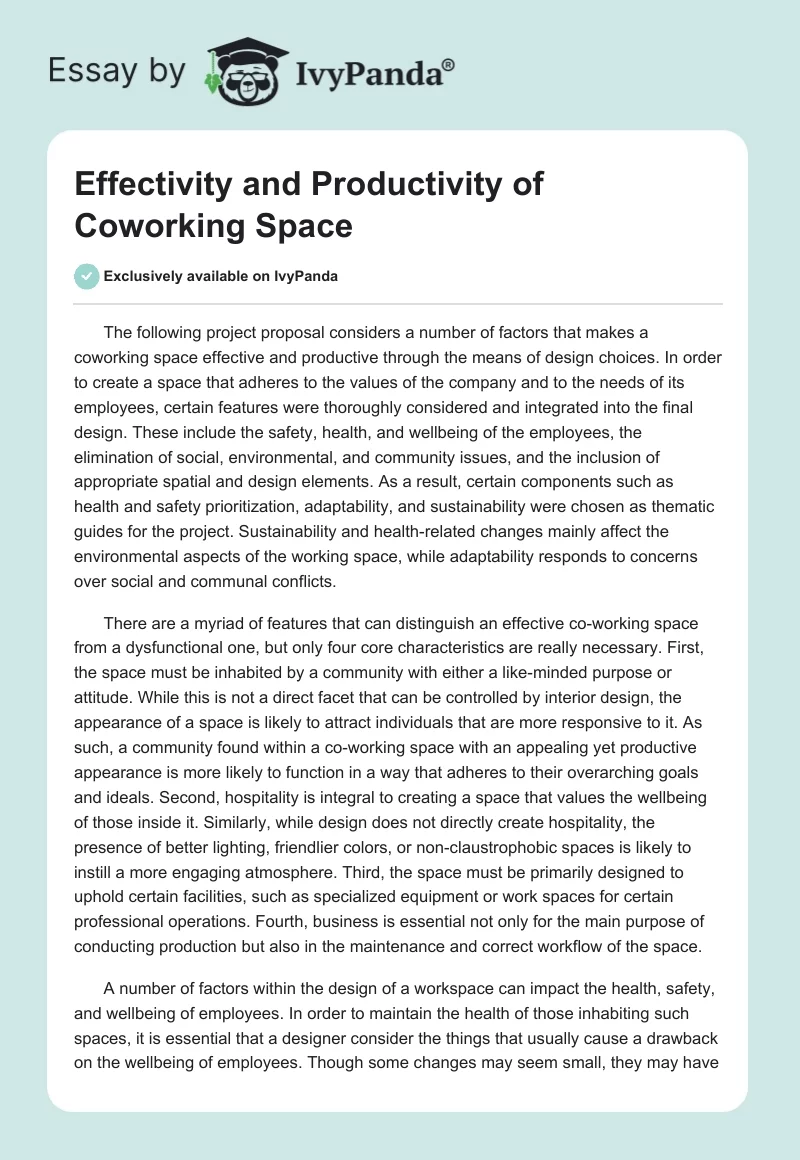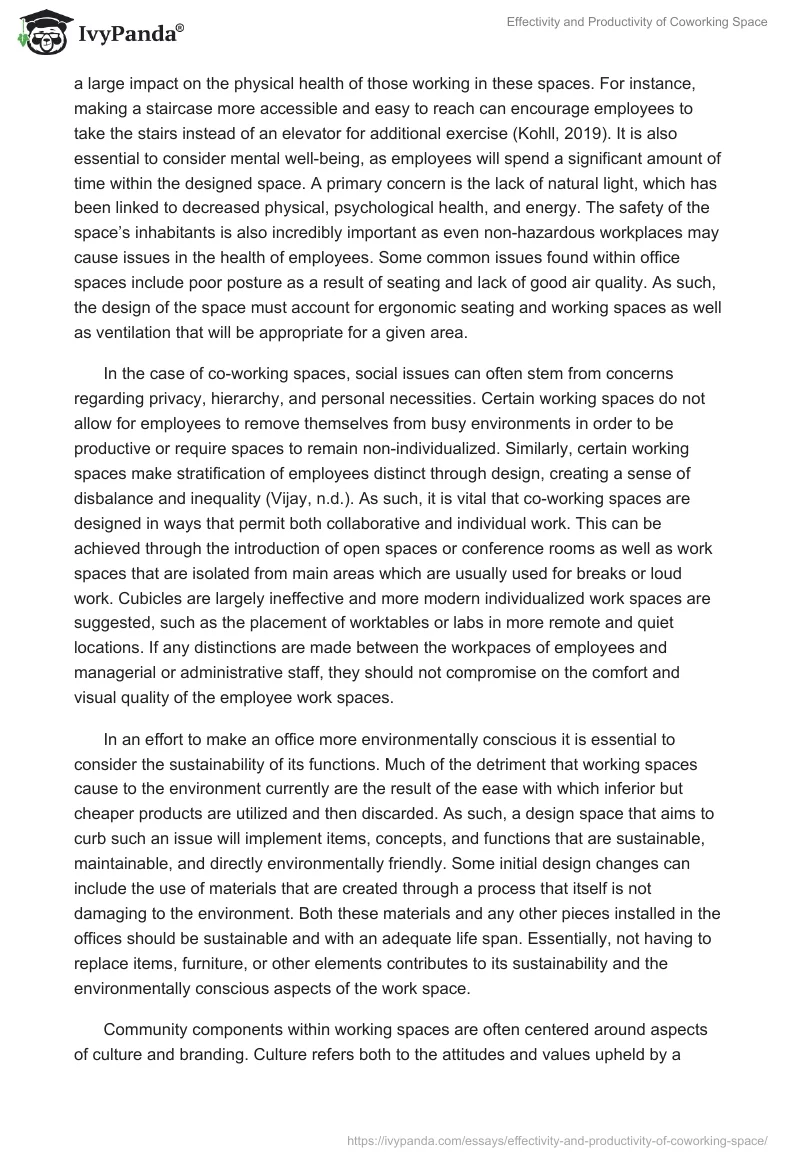The following project proposal considers a number of factors that makes a coworking space effective and productive through the means of design choices. In order to create a space that adheres to the values of the company and to the needs of its employees, certain features were thoroughly considered and integrated into the final design. These include the safety, health, and wellbeing of the employees, the elimination of social, environmental, and community issues, and the inclusion of appropriate spatial and design elements. As a result, certain components such as health and safety prioritization, adaptability, and sustainability were chosen as thematic guides for the project. Sustainability and health-related changes mainly affect the environmental aspects of the working space, while adaptability responds to concerns over social and communal conflicts.
There are a myriad of features that can distinguish an effective co-working space from a dysfunctional one, but only four core characteristics are really necessary. First, the space must be inhabited by a community with either a like-minded purpose or attitude. While this is not a direct facet that can be controlled by interior design, the appearance of a space is likely to attract individuals that are more responsive to it. As such, a community found within a co-working space with an appealing yet productive appearance is more likely to function in a way that adheres to their overarching goals and ideals. Second, hospitality is integral to creating a space that values the wellbeing of those inside it. Similarly, while design does not directly create hospitality, the presence of better lighting, friendlier colors, or non-claustrophobic spaces is likely to instill a more engaging atmosphere. Third, the space must be primarily designed to uphold certain facilities, such as specialized equipment or work spaces for certain professional operations. Fourth, business is essential not only for the main purpose of conducting production but also in the maintenance and correct workflow of the space.
A number of factors within the design of a workspace can impact the health, safety, and wellbeing of employees. In order to maintain the health of those inhabiting such spaces, it is essential that a designer consider the things that usually cause a drawback on the wellbeing of employees. Though some changes may seem small, they may have a large impact on the physical health of those working in these spaces. For instance, making a staircase more accessible and easy to reach can encourage employees to take the stairs instead of an elevator for additional exercise (Kohll, 2019). It is also essential to consider mental well-being, as employees will spend a significant amount of time within the designed space. A primary concern is the lack of natural light, which has been linked to decreased physical, psychological health, and energy. The safety of the space’s inhabitants is also incredibly important as even non-hazardous workplaces may cause issues in the health of employees. Some common issues found within office spaces include poor posture as a result of seating and lack of good air quality. As such, the design of the space must account for ergonomic seating and working spaces as well as ventilation that will be appropriate for a given area.
In the case of co-working spaces, social issues can often stem from concerns regarding privacy, hierarchy, and personal necessities. Certain working spaces do not allow for employees to remove themselves from busy environments in order to be productive or require spaces to remain non-individualized. Similarly, certain working spaces make stratification of employees distinct through design, creating a sense of disbalance and inequality (Vijay, n.d.). As such, it is vital that co-working spaces are designed in ways that permit both collaborative and individual work. This can be achieved through the introduction of open spaces or conference rooms as well as work spaces that are isolated from main areas which are usually used for breaks or loud work. Cubicles are largely ineffective and more modern individualized work spaces are suggested, such as the placement of worktables or labs in more remote and quiet locations. If any distinctions are made between the workpaces of employees and managerial or administrative staff, they should not compromise on the comfort and visual quality of the employee work spaces.
In an effort to make an office more environmentally conscious it is essential to consider the sustainability of its functions. Much of the detriment that working spaces cause to the environment currently are the result of the ease with which inferior but cheaper products are utilized and then discarded. As such, a design space that aims to curb such an issue will implement items, concepts, and functions that are sustainable, maintainable, and directly environmentally friendly. Some initial design changes can include the use of materials that are created through a process that itself is not damaging to the environment. Both these materials and any other pieces installed in the offices should be sustainable and with an adequate life span. Essentially, not having to replace items, furniture, or other elements contributes to its sustainability and the environmentally conscious aspects of the work space.
Community components within working spaces are often centered around aspects of culture and branding. Culture refers both to the attitudes and values upheld by a company, multiculturalism, and diversity. Clashes between a number of these facets are not uncommon, but they often are caused by the lack of certain features within the physical design of a workspace as much as the social and political functions of it. As such, in the case that the design or space does correspond to the needs of certain employees, it is important to introduce adaptability. In fact, the initial creation of the space must be susceptible to any later changes. Work conditions or flows may change, certain employees may leave while others may join, and other changes are unavoidable. As such, the design of the physical space must contribute to any necessary change, especially in accordance to the community inhabiting it. This can often manifest as multifunctional items, mobility, and the consideration of local cultural norms (Chang et al., 2017). Similarly, branding is essential in making the space unique and creating a company identity among the community associated with it.
The design proposal considers all the aforementioned concepts within its creation while incorporating it into spatial planning and design elements. The project prioritizes open, but strategically organized spaces that make use of natural light, adequate ventilation, and the reduction of noise pollution. Elements that will be commonly seen within the research include organic, ergonomic, and appropriate furniture, tools, and other components. Similarly, multi functionality and sustainability is important in order to promote adaptability, environmental consciousness, and community prioritization. Materials and equipment were chosen based on their negative or positive impact on the environment. Certain other essentials, especially those that are usually disposable, were replaced with more sustainable or recyclable options where possible. The larger features of the design, or those that are expected to be in use frequently, also utilize mobility where possible in order to allow employees the option to individualize or increase the comfort of a work space. In conclusion, many modern design spaces createthe general appeal of the physical appearance and the functionality of a space for its original intended purpose, but it is also vital to encourage changes that facilitate other benefits. As such, this design project attempts to introduce these new features in a seamless and beneficial way.
References
Chang, H., Darrin, D., Weeks, L. (2017). 3 tips for designing workplaces that support culture, brand, and community. Building Design and Construction. Web.
Kohll, A. (2019). How Your Office Space Impacts Employee Well-Being. Forbes. Web.
Vijay, H. K. (n.d.). Design Thinking for Social Problems: A less traversed path. Rethinking the Future. Web.


